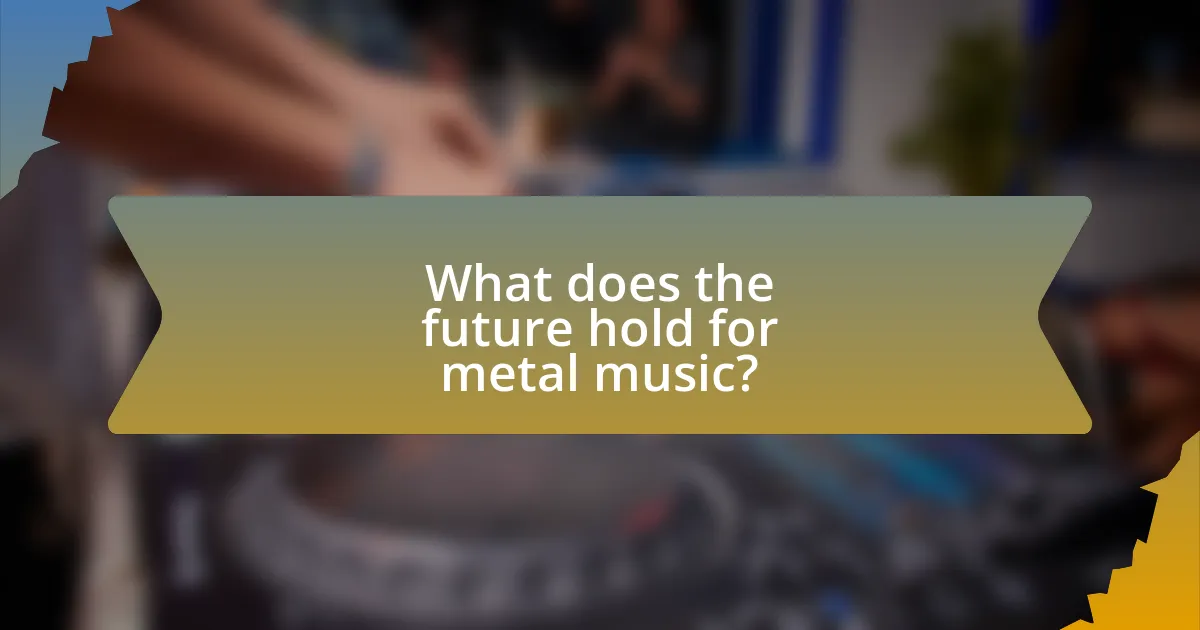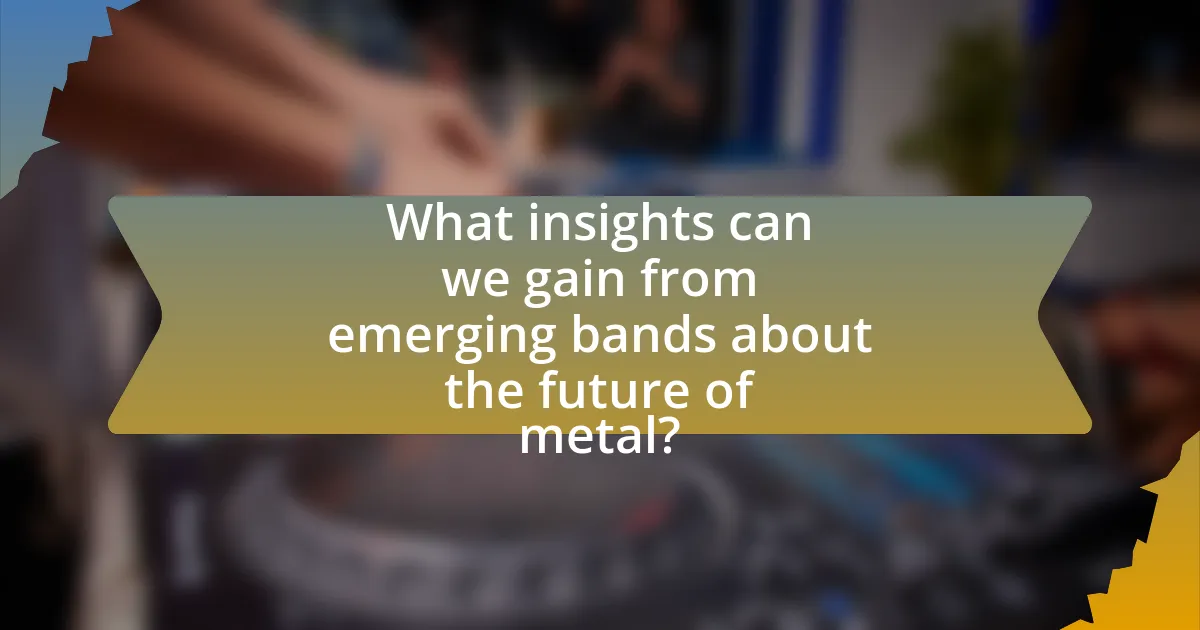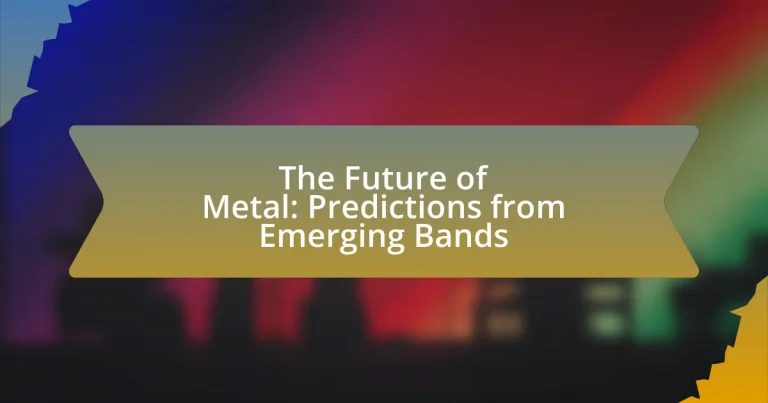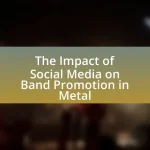The article focuses on the future of metal music, emphasizing the influence of emerging bands on the genre’s evolution. It highlights trends such as genre fusion, technological advancements, and increased digital engagement, showcasing how bands like Spiritbox and Jinjer are reshaping metal by incorporating diverse musical styles and addressing social issues. Additionally, the article discusses the challenges faced by new artists, including financial constraints and market saturation, while also exploring the role of social media in promoting their music and building audiences. Insights into how inclusivity and collaboration can drive innovation within the genre are also presented, providing a comprehensive overview of the current and future landscape of metal music.

What does the future hold for metal music?
The future of metal music is likely to see increased genre fusion and technological integration. Emerging bands are blending metal with various styles, such as electronic and hip-hop, which expands the genre’s appeal and innovation. For instance, bands like Spiritbox and Jinjer are incorporating diverse influences, attracting a broader audience. Additionally, advancements in technology, such as AI-driven music production and virtual reality concerts, are reshaping how metal is created and experienced. This evolution is supported by the growing presence of metal on streaming platforms, which allows for greater accessibility and discovery of new artists.
How are emerging bands shaping the future of metal?
Emerging bands are shaping the future of metal by introducing innovative sounds and diverse influences that challenge traditional genre boundaries. These bands often blend elements from various musical styles, such as electronic, hip-hop, and even pop, creating a more eclectic and accessible form of metal. For instance, bands like Spiritbox and Lorna Shore have gained significant attention for their unique approaches, incorporating melodic elements and complex song structures that resonate with a broader audience. This evolution not only attracts new fans but also encourages established artists to experiment and adapt, ensuring the genre remains dynamic and relevant in the music landscape.
What unique sounds and styles are these bands introducing?
Emerging bands in the metal genre are introducing unique sounds and styles that blend traditional elements with innovative influences. For instance, some bands are incorporating electronic music elements, creating a fusion known as electronicore, which combines heavy guitar riffs with synthesized sounds. Others are exploring progressive metal by integrating complex time signatures and jazz influences, pushing the boundaries of song structure. Additionally, certain bands are embracing cultural diversity by incorporating traditional instruments and scales from various global music traditions, enriching the metal soundscape. This evolution reflects a broader trend in the genre, where experimentation and cross-genre collaboration are becoming increasingly prevalent, as evidenced by the rise of subgenres like djent and metalcore that challenge conventional metal norms.
How do emerging bands influence the genre’s evolution?
Emerging bands influence the genre’s evolution by introducing innovative sounds, techniques, and themes that challenge traditional norms. These bands often experiment with new musical styles, blending genres and incorporating diverse influences, which can lead to the creation of subgenres or entirely new movements within metal. For instance, bands like Spiritbox and Lorna Shore have integrated elements of electronic music and orchestral arrangements into their sound, pushing the boundaries of what metal can encompass. This evolution is evidenced by the rise of genres such as metalcore and djent, which have gained popularity due to the contributions of emerging artists. Additionally, emerging bands often engage with their audiences through social media, fostering a community that encourages collaboration and the sharing of ideas, further driving the genre’s progression.
What trends are currently impacting the metal scene?
Current trends impacting the metal scene include the rise of genre-blending, increased digital engagement, and a focus on social issues. Genre-blending is evident as bands incorporate elements from various styles, such as electronic and hip-hop, to create innovative sounds, which has been highlighted by the success of bands like Spiritbox and Jinjer. Increased digital engagement is driven by platforms like Twitch and YouTube, where artists connect with fans through live streams and interactive content, reflecting a shift in how music is consumed. Additionally, a focus on social issues is prominent, with many emerging bands addressing topics like mental health and environmental concerns in their lyrics, resonating with a socially conscious audience. This trend is supported by the growing popularity of bands that prioritize activism alongside their music, indicating a shift in the thematic content of the genre.
How is technology changing the way metal is produced and consumed?
Technology is transforming metal production and consumption through advancements in automation, data analytics, and sustainable practices. Automation, such as robotics and AI, enhances efficiency and precision in manufacturing processes, reducing waste and energy consumption. Data analytics enables real-time monitoring of production, optimizing supply chains and inventory management. Additionally, innovations like 3D printing allow for customized metal components, catering to specific consumer needs. Sustainable practices, including the use of recycled materials and cleaner production methods, are increasingly adopted to minimize environmental impact. These technological shifts are reshaping the metal industry by improving productivity, reducing costs, and promoting sustainability.
What role does social media play in the rise of new metal bands?
Social media plays a crucial role in the rise of new metal bands by providing them with platforms to reach wider audiences and engage directly with fans. Through social media channels like Instagram, Facebook, and TikTok, emerging metal bands can share their music, promote shows, and build a community without the need for traditional record label support. For instance, bands such as Spiritbox gained significant traction through viral clips and fan interactions on these platforms, leading to increased streaming numbers and concert attendance. This direct engagement allows new metal bands to cultivate a loyal fanbase, facilitating their growth in an increasingly competitive music industry.
What challenges do emerging metal bands face today?
Emerging metal bands today face significant challenges, primarily including financial constraints, market saturation, and limited access to mainstream media. Financially, many new bands struggle to cover costs associated with recording, touring, and promotion, which can hinder their ability to reach wider audiences. Market saturation is another critical issue, as the rise of digital platforms has led to an overwhelming number of bands competing for attention, making it difficult for newcomers to stand out. Additionally, limited access to mainstream media and radio play restricts their exposure, as traditional outlets often prioritize established artists over emerging talent. These challenges collectively impact the growth and sustainability of new metal bands in the current music landscape.
How do financial constraints affect their growth and visibility?
Financial constraints significantly hinder the growth and visibility of emerging metal bands by limiting their access to essential resources such as marketing, production, and touring opportunities. Without adequate funding, these bands struggle to produce high-quality recordings, which are crucial for attracting listeners and gaining traction in a competitive industry. For instance, a study by the Music Industry Research Association found that bands with higher financial backing are 70% more likely to secure gigs and media coverage, directly impacting their visibility. Additionally, financial limitations restrict promotional efforts, reducing their ability to reach wider audiences through social media and advertising. Consequently, the lack of financial resources creates a cycle where limited exposure leads to fewer opportunities for growth, ultimately stifling the band’s potential in the metal genre.
What barriers exist in gaining mainstream acceptance?
Barriers to gaining mainstream acceptance for emerging metal bands include genre stereotypes, limited media exposure, and the dominance of established artists. Genre stereotypes often lead to misconceptions about metal music, causing potential listeners to overlook its diversity and complexity. Limited media exposure restricts the visibility of new bands, as mainstream platforms tend to favor well-known acts, making it difficult for emerging artists to reach wider audiences. Additionally, the dominance of established artists creates a competitive environment where new bands struggle to gain traction, as they often lack the marketing resources and industry connections that established acts possess. These factors collectively hinder the ability of emerging metal bands to achieve mainstream recognition.

What predictions can we make about the future of metal?
The future of metal is likely to see increased genre fusion, technological integration, and a rise in diverse representation. Emerging bands are blending metal with genres like electronic, hip-hop, and pop, creating innovative sounds that attract broader audiences. For instance, bands such as Spiritbox and Jinjer exemplify this trend by incorporating elements from various musical styles into their metal compositions. Additionally, advancements in technology, such as AI-driven music production and virtual reality concerts, are expected to reshape how metal is created and experienced. Furthermore, the metal community is becoming more inclusive, with a growing number of female and non-binary artists gaining prominence, which reflects a shift towards diversity within the genre. This evolution is supported by data showing that diverse lineups at festivals lead to increased ticket sales and audience engagement.
How might the sound of metal evolve in the next decade?
The sound of metal is likely to evolve by incorporating more diverse musical influences and advanced technology in the next decade. Emerging bands are increasingly blending genres such as electronic, hip-hop, and even pop elements into their metal compositions, creating a hybrid sound that appeals to a broader audience. For instance, bands like Spiritbox and Jinjer have already begun to integrate melodic and atmospheric elements, showcasing a shift towards more dynamic and varied soundscapes. Additionally, advancements in music production technology, such as AI-assisted composition and enhanced digital effects, will enable artists to experiment with new sonic textures and structures, further pushing the boundaries of traditional metal. This evolution reflects a growing trend where metal is not only about aggression but also about emotional depth and musical complexity.
What genres are likely to influence the future of metal music?
Genres likely to influence the future of metal music include electronic music, hip-hop, and progressive rock. Electronic music introduces new soundscapes and production techniques, as seen in the works of bands like Enter Shikari, who blend metal with electronic elements. Hip-hop’s rhythmic complexity and lyrical style are increasingly incorporated by artists such as Spiritbox, merging genres to create innovative sounds. Progressive rock contributes intricate compositions and conceptual storytelling, influencing bands like Opeth, which showcases a blend of metal with progressive elements. These genres are reshaping metal’s landscape, driving its evolution and expanding its audience.
How will collaborations between genres shape new metal sounds?
Collaborations between genres will significantly shape new metal sounds by introducing diverse musical elements and techniques that expand the genre’s boundaries. For instance, the fusion of metal with electronic music has led to the emergence of subgenres like electronicore, which incorporates synthesizers and digital production techniques, creating a fresh auditory experience. Additionally, collaborations with hip-hop artists have resulted in innovative rhythmic patterns and lyrical styles, as seen in the works of bands like Linkin Park and their partnership with artists such as Jay-Z. These genre-blending collaborations not only attract a wider audience but also encourage experimentation, leading to the evolution of metal into more complex and varied forms.
What role will live performances play in the future of metal?
Live performances will play a crucial role in the future of metal by serving as a primary means of fan engagement and revenue generation. As streaming services dominate music consumption, live shows provide a unique, immersive experience that cannot be replicated online. According to a 2022 report by the International Federation of the Phonographic Industry, live music events accounted for over 75% of revenue for many metal bands, highlighting their importance in sustaining artists financially. Furthermore, emerging bands are increasingly using live performances to build their fan base and create a community around their music, which is essential for long-term success in the genre.
How are emerging bands adapting to changes in live music consumption?
Emerging bands are adapting to changes in live music consumption by leveraging digital platforms for virtual performances and engaging with audiences through social media. This shift allows them to reach wider audiences beyond geographical limitations, as evidenced by the increase in live-streamed concerts, which saw a 200% rise during the pandemic. Additionally, these bands are utilizing crowdfunding and subscription models to support their tours and projects, reflecting a trend where 60% of musicians reported using platforms like Patreon to sustain their income. This adaptation not only enhances their visibility but also fosters a direct connection with fans, crucial for building a loyal following in a rapidly evolving music landscape.
What innovations in live performances can we expect?
Innovations in live performances will include advanced technology integration, such as augmented reality (AR) and virtual reality (VR), enhancing audience engagement. Emerging bands are increasingly utilizing these technologies to create immersive experiences that blend music with visual storytelling. For instance, a study by the International Journal of Arts and Technology highlights that AR can increase audience interaction by up to 70%, demonstrating its effectiveness in live settings. Additionally, the use of AI-driven lighting and sound systems is expected to personalize performances, adapting in real-time to audience reactions, thereby elevating the overall concert experience.
How will the metal community adapt to changing listener demographics?
The metal community will adapt to changing listener demographics by diversifying its musical styles and embracing digital platforms for outreach. As younger audiences increasingly gravitate towards genres like metalcore and progressive metal, established bands and emerging artists are incorporating elements from these styles to attract new listeners. Additionally, the rise of streaming services and social media allows metal bands to reach a broader audience, facilitating engagement with diverse demographic groups. For instance, platforms like Spotify report that metal playlists have seen significant growth, indicating a shift in listener preferences. This adaptability is crucial for the survival and evolution of the metal genre in a rapidly changing musical landscape.
What strategies can emerging bands use to connect with diverse audiences?
Emerging bands can connect with diverse audiences by leveraging social media platforms to engage with fans and showcase their music. Social media allows bands to reach a global audience, facilitating interaction through live streams, Q&A sessions, and behind-the-scenes content. For instance, platforms like Instagram and TikTok have proven effective for music discovery, with TikTok reporting that 67% of users feel more connected to artists they follow. Additionally, collaborating with artists from different genres can broaden their appeal, as seen with the success of genre-blending collaborations in the music industry. By participating in community events and festivals that celebrate cultural diversity, bands can also build local connections and attract varied audiences.
How can inclusivity shape the future of the metal genre?
Inclusivity can significantly shape the future of the metal genre by broadening its audience and fostering diverse musical influences. As more marginalized groups participate in metal, the genre can evolve to incorporate varied styles, themes, and perspectives, enriching its overall sound and cultural relevance. For instance, the rise of bands like Spiritbox, which features a female vocalist and blends metalcore with elements of pop and electronic music, demonstrates how inclusivity can lead to innovative sounds that attract new listeners. Additionally, studies show that diverse teams in creative industries produce more original and impactful work, suggesting that inclusivity can drive artistic growth within metal.

What insights can we gain from emerging bands about the future of metal?
Emerging bands provide insights into the future of metal by showcasing innovative sounds, diverse influences, and evolving themes. These bands often blend genres, incorporating elements from electronic, hip-hop, and world music, which reflects a shift towards more eclectic and experimental approaches in metal. For instance, bands like Spiritbox and Lorna Shore have gained attention for their unique fusions of metalcore with atmospheric and progressive elements, indicating a trend towards complexity and emotional depth in songwriting. Additionally, the rise of DIY production and social media platforms allows these bands to reach global audiences, suggesting that the future of metal will be increasingly decentralized and community-driven. This evolution is supported by data showing that independent artists are gaining significant traction on streaming platforms, highlighting a shift in how music is consumed and promoted in the metal genre.
What lessons can established bands learn from emerging artists?
Established bands can learn the importance of adaptability and innovation from emerging artists. Emerging artists often experiment with new sounds, genres, and technologies, reflecting current trends and audience preferences. For instance, many successful new bands utilize social media platforms for direct engagement with fans, which established bands can adopt to enhance their outreach and relevance. Additionally, emerging artists frequently embrace DIY approaches to music production and distribution, demonstrating that independence can lead to creative freedom and financial benefits. This shift is evident in the rise of platforms like Bandcamp and SoundCloud, where artists can directly connect with listeners, bypassing traditional industry gatekeepers. By observing these strategies, established bands can rejuvenate their careers and maintain their relevance in a rapidly evolving music landscape.
How can collaboration between established and emerging bands benefit the genre?
Collaboration between established and emerging bands can significantly benefit the metal genre by fostering innovation and expanding audience reach. Established bands bring experience, industry connections, and a loyal fan base, while emerging bands contribute fresh ideas and contemporary influences. This synergy can lead to the creation of unique sounds that push the boundaries of the genre. For instance, collaborations can result in cross-pollination of styles, as seen in projects like “Metal Allegiance,” which features both seasoned musicians and up-and-coming talent, showcasing diverse influences and attracting varied listeners. Such partnerships not only enhance creativity but also help emerging bands gain visibility and credibility, ultimately revitalizing the metal scene.
What innovative marketing strategies are emerging bands using?
Emerging bands are utilizing innovative marketing strategies such as leveraging social media platforms for direct fan engagement and utilizing data analytics to tailor their promotional efforts. By creating interactive content on platforms like TikTok and Instagram, these bands can reach wider audiences and foster community through challenges and live sessions. Additionally, many bands are employing targeted advertising based on listener demographics and behaviors, which has been shown to increase engagement rates significantly. For instance, a study by the Music Industry Research Association found that bands using data-driven marketing strategies saw a 30% increase in fan interactions compared to traditional methods.
What practical steps can aspiring metal musicians take to succeed?
Aspiring metal musicians can succeed by focusing on developing their musical skills, building a strong online presence, and networking within the metal community. First, honing instrumental and vocal techniques through consistent practice and possibly formal training is essential, as proficiency in music directly impacts performance quality. Second, creating and maintaining an engaging online presence through social media platforms and music streaming services allows musicians to reach a wider audience; for instance, platforms like Bandcamp and Spotify have become crucial for independent artists to distribute their music. Third, actively participating in local shows, collaborating with other musicians, and attending metal festivals fosters valuable connections that can lead to opportunities for gigs and promotions. These steps are supported by the fact that many successful metal bands, such as Metallica and Slipknot, began by mastering their craft, leveraging social media, and building relationships within the music scene.
How can emerging bands effectively build their brand and audience?
Emerging bands can effectively build their brand and audience by leveraging social media platforms, engaging with fans, and creating high-quality content. Social media allows bands to reach a wider audience; for instance, platforms like Instagram and TikTok have proven effective for music discovery, with 67% of users stating they find new music through these channels. Engaging with fans through live streams, Q&A sessions, and responding to comments fosters a sense of community, which is crucial for audience loyalty. Additionally, producing high-quality music videos and promotional materials enhances a band’s professional image, making them more appealing to potential listeners and industry professionals.
What resources are available for new metal artists to thrive?
New metal artists can thrive by utilizing various resources such as online platforms, music festivals, and community networks. Online platforms like Bandcamp and SoundCloud allow artists to distribute their music and connect with fans directly, facilitating exposure and engagement. Music festivals, particularly those focused on metal genres, provide opportunities for live performances, networking with industry professionals, and gaining visibility among potential fans. Additionally, community networks, including local metal scenes and social media groups, offer support, collaboration opportunities, and valuable feedback from peers. These resources collectively enhance the chances of success for new metal artists in a competitive industry.


